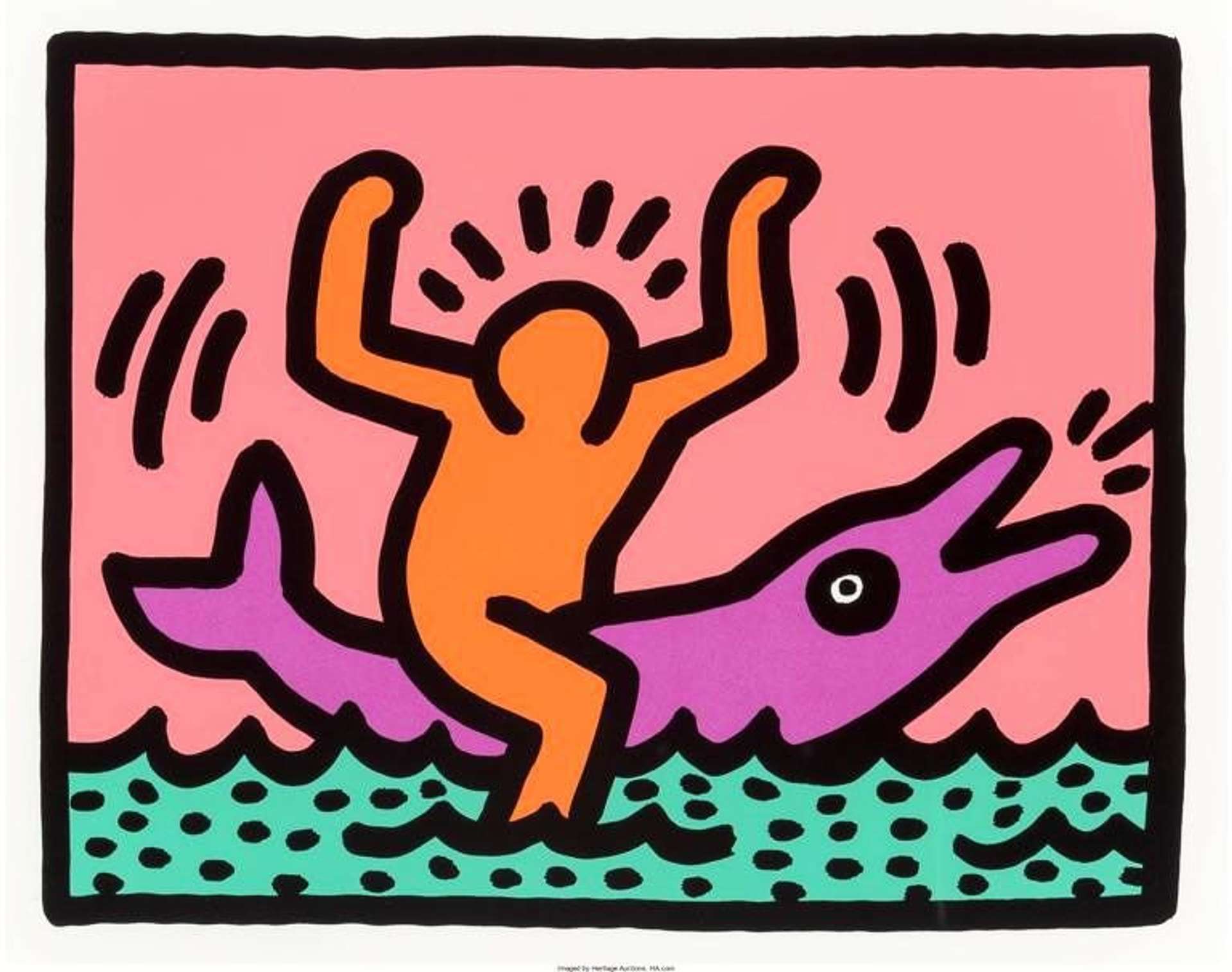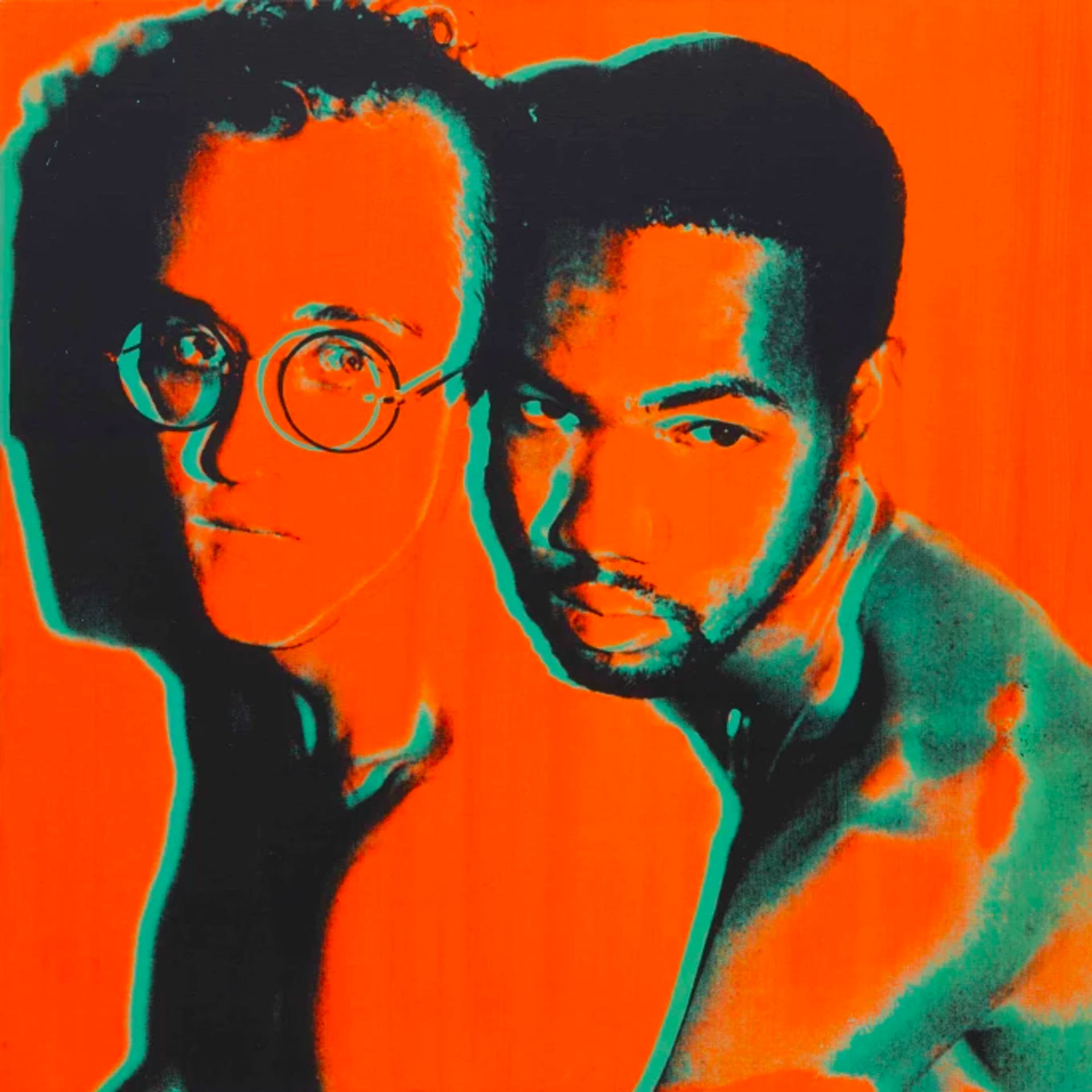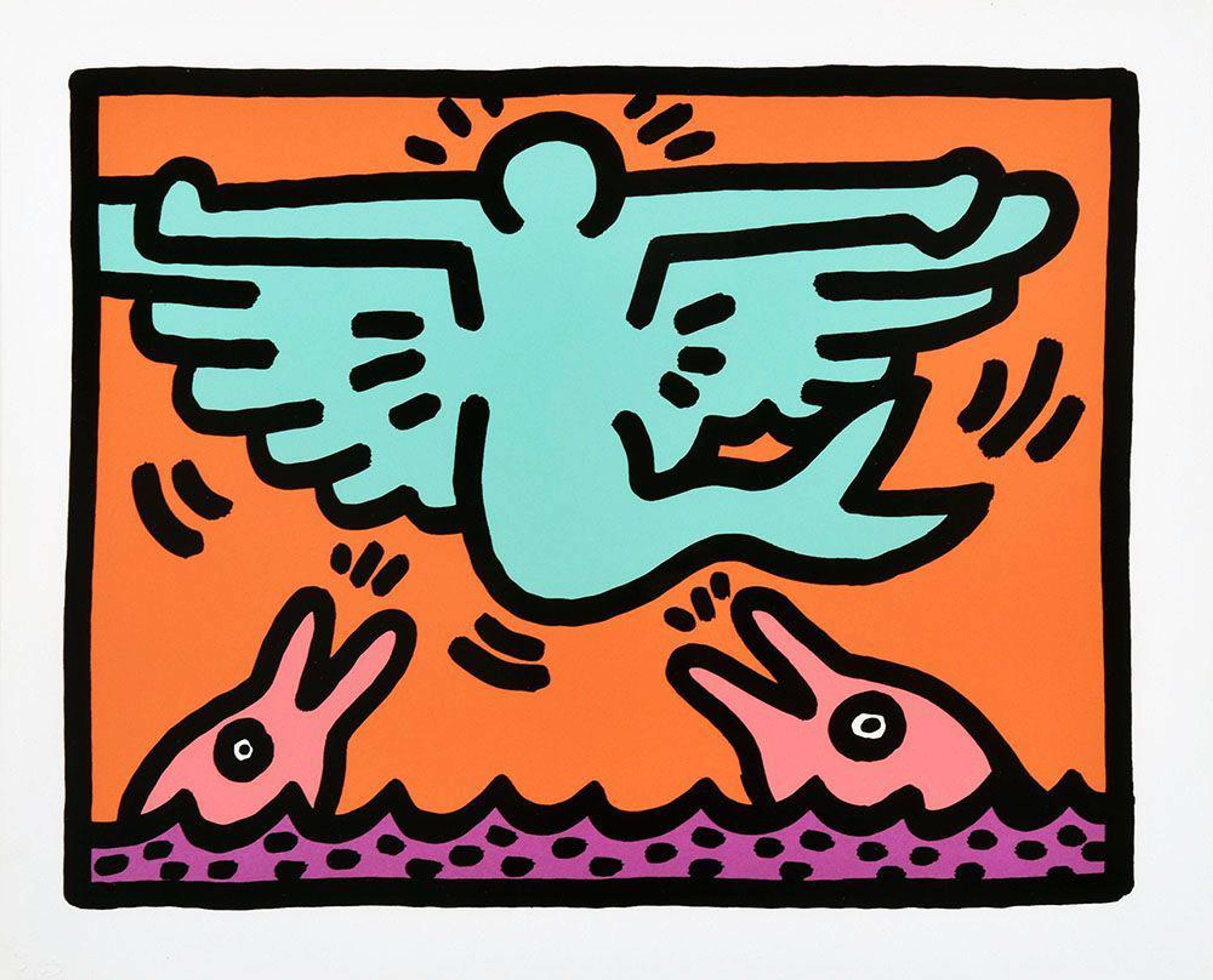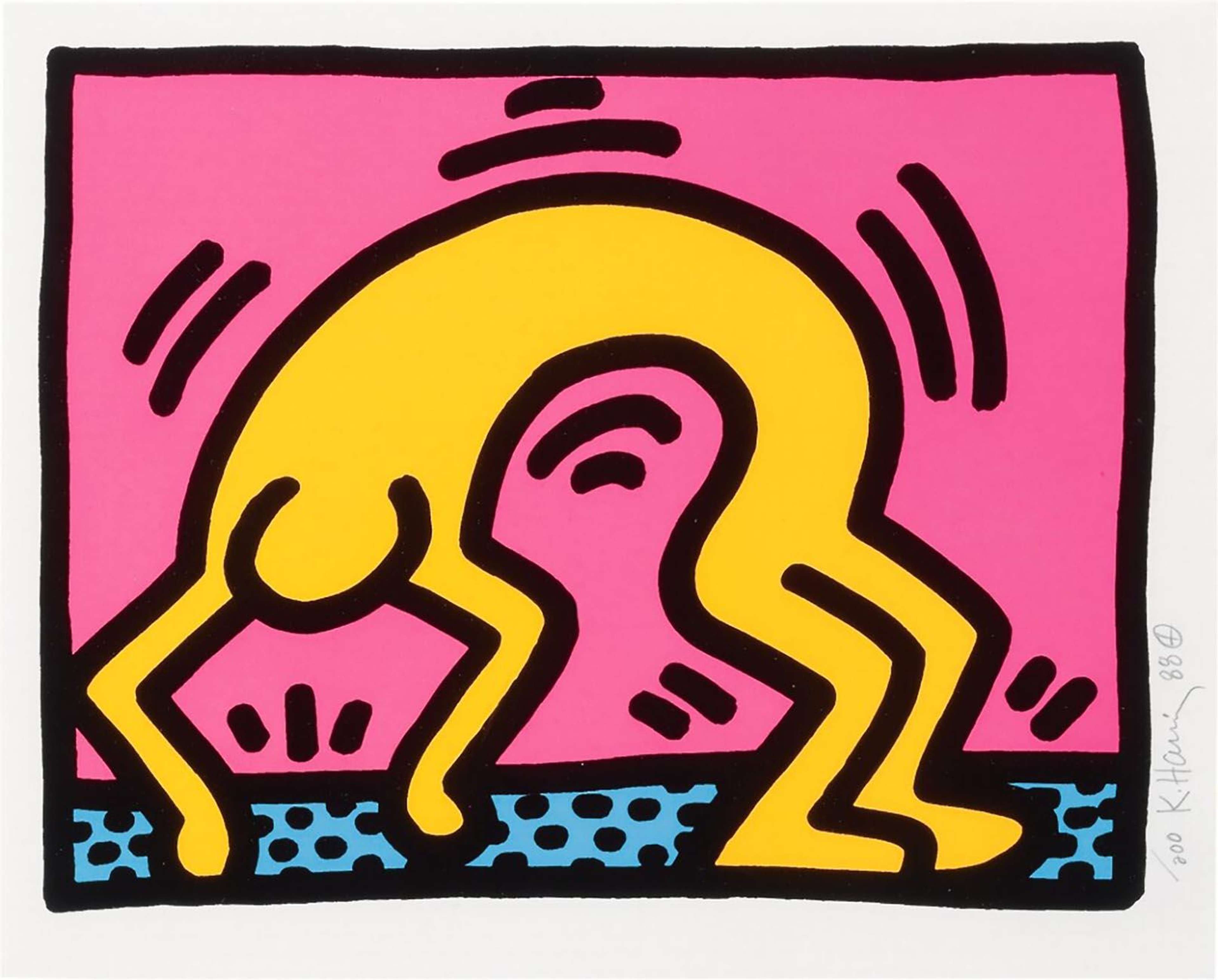The House That Shafrazi Built

 Angel © Keith Haring 1990
Angel © Keith Haring 1990 
Interested in buying or selling
Keith Haring?

Keith Haring
249 works
At the heart of Keith Haring's ascent to fame stood Tony Shafrazi, a visionary that would thrust Pop Art luminaries into the spotlight. Known for his audacious "Kill All Lies" inscription onto Pablo Picasso's Guernica, Shafrazi's journey from critiquing a masterpiece to championing artists, embodies a story as extraordinary as it is impactful. Shafrazi, recognised as a provocateur, foreshadowed his pivotal role in amplifying the voices of artists dedicated to challenging societal norms. This begs the question: Is there a better patron for Haring than one whose own creations are deeply rooted in defiance and dialogue with the establishment?
Who is Tony Shafrazi
Shafrazi, originating from Abadan, Iran, harboured a passion for art from a young age, refining his skills in painting and sculpture. He found himself navigating England in lieu of an American dream, per his father's wishes, at a boarding school by age thirteen. Immersed in the vibrant cultural revolution of London from the mid-1950s through the late 1960s, Shafrazi witnessed firsthand the burgeoning Pop Art movement, a period marked by dynamic shifts in art, music, theatre, and fashion. This era, defined by the fusion of everyday objects into high art, greatly influenced his trajectory. His academic journey led him to Hammersmith College in 1960, focusing on sculpture and culminating in a comprehensive thesis on African sculpture. This pursuit transitioned into a prestigious spot at the Royal College of Art in London, enriching his education further from 1964 to 1967.
Within this creative and intellectual melting pot, Shafrazi forged significant connections with renowned figures such as David Hockney and Patrick Caulfield, among other luminaries. These relationships, built on a shared passion for art and innovation, impacted his formative years, all while his aspirations continually veered towards America, setting the stage for his future endeavours in the art world.
Driven by a desire to immerse himself in the vibrant art scenes of the States, Shafrazi's journey to New York unfolded as a defining moment in his life. As luck would have it, Shafrazi found himself neighbouring Andy Warhol's Factory. The pair eventually met, sparking an organic, and quite fortunate friendship.
The House That Shafrazi Built: The Tony Shafrazi Gallery
Shafrazi's debut in the gallery world began in Tehran during the early '70s, a time rich with cultural flourishing under Iran's royal support. Fueled by ambition and a vision for bridging cultures, he launched his namesake gallery, driven by dissatisfaction with Tehran's Museum of Contemporary Art's pace and a deep-seated desire for a presence in New York. His initial exhibition showcased Zadikian, an artist whose gold-laden work perfectly encapsulated Shafrazi's belief in art as a catalyst for change. This move, amid Tehran's cultural bloom, not only set the foundation for Shafrazi's celebrated career but also marked a pivotal moment where art began to challenge and reshape global dialogues and perspectives.
New York Ascendancy: Shafrazi's Avant-Garde Platform
After some time at the Tehran Museum of Contemporary Art, Shafrazi returned to the United States, opening his New York gallery in 1979. This space, originally his apartment, soon evolved into a crucible for the avant-garde, heralding the voices of artists poised to redefine the art narrative. Throughout the 1980s, the Soho gallery emerged as a pivotal platform, spotlighting the innovative talents of Haring as well as other contemporaries like Jean-Michel Basquiat.
 Painting Four Hands Exhibition Poster © Photograph by Essie King 2023
Painting Four Hands Exhibition Poster © Photograph by Essie King 2023Warhol and Basquiat: A Controversial Collaboration
In 1985, upon Andy Warhol's request, Bruno Bischofberger approached Shafrazi to curate an exhibition showcasing the collaborative works of Warhol and Basquiat. This led to the unveiling of the Warhol / Basquiat: Paintings exhibition at the Tony Shafrazi Gallery. However, the reception from the public and critics alike was lukewarm, with many perceiving the show as a commercial endeavour rather than a genuine artistic collaboration. Critics argued that Basquiat was seeking fame and exposure, whereas Warhol was viewed as attempting to recapture his past successes through the vitality of a younger, emerging artist.
In any scenario, it’s clear that without Shafrazi’s foresight, more recent exhibitions such as Painting Four Hands might not have come to fruition without the unlikely pair’s inaugural show at Shafrazi’s gallery.
Championing Social Discourse Through Art
Through a number of exhibitions that showcased Basquiat's explorations of identity, race, and societal structures, the Tony Shafrazi Gallery became a vehicle for a dialogue on the African American experience, leveraging art as a medium for social critique. Basquiat's potent visual language, anatomical motifs, and confrontational themes, epitomised the gallery's commitment to presenting art that challenges and engages with pressing cultural narratives.
Shafrazi’s influence extended beyond representation, becoming instrumental in conceptualising exhibitions that expanded the confines of contemporary art. His gallery was a dynamic environment where artists could experiment and engage with critical discourses, pushing their creative limits. Shafrazi’s advocacy for provocative and socially conscious art helped to nurture a vibrant community and fostered an atmosphere of innovation and collaboration.
Keith Haring: The Early Years
Born in Pennsylvania in 1958, Haring's early life was marked by a voracious appetite for drawing, a medium through which he could channel his observations of the world around him. This period was crucial, as it laid the foundation for his later work, characterised by themes of activism, community, and social justice. Haring's inspiration was deeply rooted in the street culture of New York City in the 1980s, a culture vibrant with graffiti that spoke the language of rebellion and freedom.
The transition of Haring's art from subway walls to gallery spaces was not just a physical shift but represented a significant evolution in the perception of street art. His work dismantled the barriers between high art and public art, challenging the elitism of the art world and democratising the art consumption process. Haring's art, with its distinctive, bold lines and expressive figures, delved into themes of race, identity, and representation, engaging with societal issues in a manner that was both accessible and provocative.
From his Free South Africa series to his Pop Shop, Haring's career underscores his commitment to using art as a tool for advocacy, a testament to the power of visual language in enacting societal change. His work remains a critical point of engagement for discussions around the implications of race and identity in art, inviting a deeper, more critical examination of the societal structures that art both reflects and challenges. Through his journey, Haring not only redefined the boundaries of art but also left a sizable mark on the discourse around the societal responsibilities of the artist.
The Shafrazi and Haring Partnership
Shafrazi's decision to exhibit Haring's work in his gallery was a pivotal moment for both the artist and the gallery. This collaboration launched Haring into the upper echelons of the art world, providing him with a platform to reach a wider audience and engage with international art markets. For Shafrazi, representing Haring reinforced the gallery's reputation as a breeding ground for artists who were not only technically proficient but also deeply engaged with the cultural and political zeitgeists of their time.
Under Shafrazi’s guidance, Haring’s work underwent a transformation, becoming more ambitious in scale and scope. The gallery facilitated collaborations, exhibitions, and projects that allowed Haring’s art to infiltrate various domains, from galleries and museums to public spaces and commercial products. Shafrazi was a catalyst for Haring’s creativity, encouraging the artist to explore new mediums and platforms, amplifying Haring's social and political messages.
The partnership between Haring and Shafrazi illustrates the impact that a visionary figure can have on an artist's career. Shafrazi's belief in Haring's talent and his commitment to providing a platform for challenging art were instrumental in propelling Haring to international stardom. This collaboration between artist and gallerist is a testament to the power of shared vision and mutual respect in the creative process. Through their combined efforts, they not only advanced Haring’s career but also contributed to the dynamic and transformative energy of the contemporary art scene.
The Impact of Shafrazi and Haring’s Collaboration
The collaboration between Shafrazi and Haring not only marked a significant period in the careers of both the visionary gallerist and the iconic artist but also laid a foundational stone for the future of contemporary art galleries and artists. Their partnership, characterised by mutual respect and a shared commitment to art as a medium for political commentary and social change, has had a lasting influence on the way artists collaborate with galleries and the role of galleries in nurturing artistic talent.
The impact of their collaboration extended beyond the confines of Shafrazi's gallery walls, setting a precedent for future artists and galleries. It demonstrated the potential of a symbiotic relationship between artist and gallerist, where the gallery serves not just as a space for exhibiting art, but as a platform for advocacy, innovation, and cultural dialogue. This model has inspired a generation of galleries to take a more active role in their artists' careers, working together to amplify their voices and messages.
Haring’s work, celebrated for its vibrant imagery and profound social commentary, continues to resonate deeply within art and society. His art's accessibility and engagement with issues like AIDS awareness, LGBTQ+ rights, and racial equality have cemented his legacy as a pioneer of art as activism. Haring's influence persists in contemporary art practices, where the intersection of art and activism remains a vital discourse.
Pop Shop: Keith Haring’s Magnum Opus
Shafrazi's decision to host a solo exhibition for Haring not only spotlighted Haring's talent but also acted as a catalyst in the artist's career, setting the stage for broader public engagement. This exhibition emphasised Haring's role as a pivotal figure in the art community, enhancing his visibility and influence. This recognition paved the way for innovative ventures like Haring’s Pop Shop, where his art directly interacted with the public. Shafrazi's early endorsement of Haring was instrumental in the artist's journey towards democratising art, illustrating how strategic support within the art world can have far-reaching effects on an artist's ability to reach and resonate with a wider audience.
The Pop Shop was a tangible manifestation of Haring's democratic art ethos, stocking a wide array of items that appealed to diverse audiences. From exclusive art pieces and limited prints for the discerning collector to affordable merchandise like T-shirts, posters, and buttons, the Pop Shop made Haring's art universally accessible. This approach not only broadened Haring's reach beyond the art elite but also transformed everyday items into carriers of his vibrant art, enabling people from all walks of life to engage with and personally own a piece of Haring's legacy. Through the Pop Shop, Haring ensured his vision was shared as widely as possible, truly embodying the philosophy that "art is for everyone."
Beyond the Canvas: Haring's Cultural Influence
Beyond the canvas, Haring's art found resonance in the realms of fashion, music, and design, illustrating his versatility and the broad appeal of his visual language. Collaborations with designers like Vivienne Westwood and brands such as Swatch brought Haring's iconic motifs to clothing and accessories, blending high art with street culture. His involvement in the music scene, creating album covers and backdrops for concerts, further cemented his influence across cultural domains. Haring's art was not confined to galleries; it was worn, lived, and experienced, making him an integral figure in the popular culture of the 1980s and beyond.
Haring's activism was significantly personal and political. As a prominent figure in the LGBTQ+ community, he utilised his art as a tool for advocacy and education, especially during the AIDS crisis of the 1980s. Haring's own diagnosis with AIDS further fueled his commitment to raising awareness and funds for research. Works like the Fertility Suite celebrated life and creation, even in the face of a devastating epidemic, while his Silence=Death pieces directly confronted the social and political neglect of the AIDS crisis. Haring's art became synonymous with the fight against AIDS, embodying the urgency and resilience of a community striving for recognition and rights.
Haring's Free South Africa series is another testament to his commitment to social justice, using his art to protest against apartheid. These works, characterised by their bold lines and poignant imagery, not only demonstrated Haring's solidarity with the oppressed but also showcased his ability to address global injustices through his distinct visual language.
The impact of Keith Haring's work on subsequent generations of artists is immeasurable. His commitment to making art accessible, combined with his activism, has inspired artists worldwide to view their work as a medium for social change. Haring's influence is seen in the proliferation of street art and in the practices of contemporary artists who blend art and activism. His legacy is a reminder of the power of art to transcend aesthetics, serving as a catalyst for dialogue, resistance, and transformation.
Celebrating Keith Haring: A 20th Anniversary Exhibition at Tony Shafrazi Gallery
In 2010, the Tony Shafrazi Gallery debuted its Keith Haring 20th Anniversary exhibition, a heartfelt homage celebrating two decades since Haring’s passing. This electric collection, encompassing over 50 works, including Haring’s iconic subway drawings, paintings, and sculptures, captured the essence of Haring's spirited and socially engaged artistry. This gathering of Haring's work, while familiar, reveals the timeless appeal and significance of his contributions to art and activism.
Shafrazi's Legacy of Innovation
Tony Shafrazi Gallery has established his gallery as a significant force in the contemporary art world, renowned for showcasing an impressive roster of artists including Andy Warhol, Francis Bacon, and Ed Ruscha. Continuously at the forefront of the art scene, the gallery upholds its tradition of presenting groundbreaking exhibitions that spotlight the works of these iconic figures. Through its dynamic curation, the gallery not only celebrates the enduring legacies of these artists but also fosters a dialogue between their influential works and contemporary audiences. The Tony Shafrazi Gallery remains a pivotal space for experiencing the evolution of modern art, cementing its status as a hub of cultural innovation and artistic excellence.


















